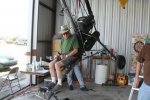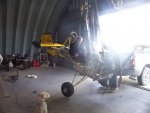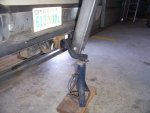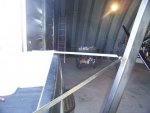Michael, you may understand what raytork is saying but I'm not clear.
I think he is saying, that along with clearance at the top, that the side of the gyro might hit the boom when the gyro is raised. If he isn't saying that then I would think that it this would have to be taken into consideration. The wider the gyro the more likely the problem. Flattening the boom angle where the top of the lifting cable is more than 4' from the base would help.
The lateral stability that raytork mentions could be mitigated by a wide boom base on the ground as you have mentioned. I don't know the nomenclature but something similar to the outriggers that back hoes use.
You need to know that there are some gyros that, when lifted, hang down so much that there can be a problem getting the nose wheel off the ground. During the double hang part of a Cg determination hang test at Bensen Days '07, C. Beaty's gyro hung at such an angle that Chuck was almost standing in the rudder pedals. See the attached picture. He was swift enough to know that the seat belt needed to be fastened!
A SportCopter couldn't be lifted high enough to get the nose wheel off the ground. But I can't remember if this was during the teeter bolt hang test or during the double hang test. So be prepared to short couple between the teeter bolt and the lifting cable so you can use all the lift height. If you do Cg determination hang tests then you need to be aware that there may be a problem selecting the hang point for the 2nd part of the test. A well thought out bridle would help. They had to improvise at Bensen Days.




